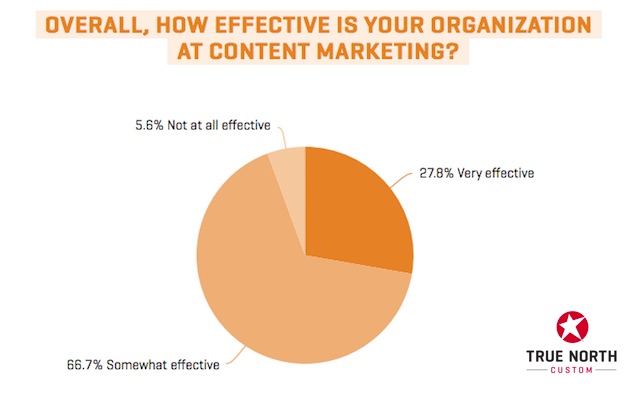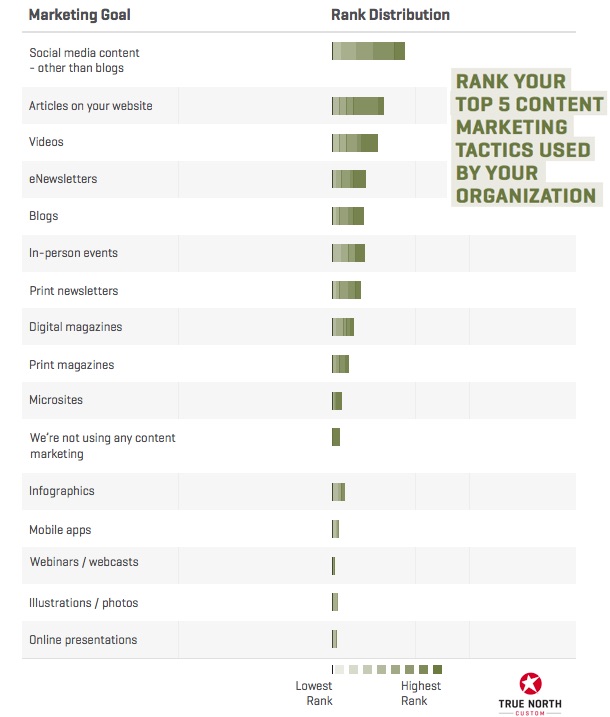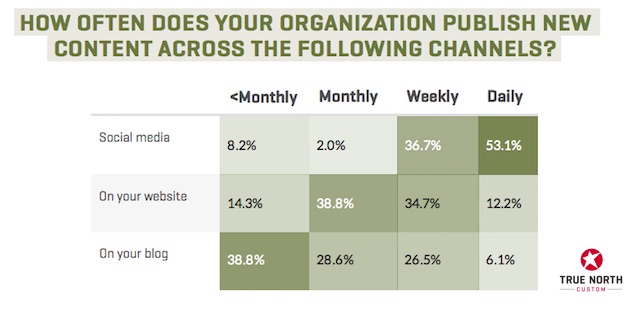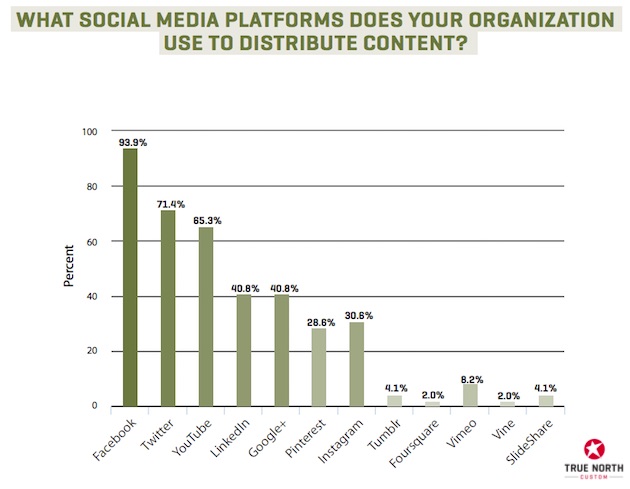
Even if you’ve worked in healthcare for all of five minutes, you’ve probably heard about the power of content marketing. This marketing style, which is enjoying tremendous success in other industries, has become a staple recommendation to better connect with healthcare-seekers.
While there is tremendous potential in content marketing, the challenge lies in the execution.
Making blanket recommendations is easy. Want to increase revenue? Some will tell you that social media is the way forward. Others swear by blogs, videos, or email newsletters.
Usually, we are limited to only our personal experiences with content marketing – or maybe a few anecdotes from our healthcare colleagues.
What’s happening with content marketing in the industry at large?
What’s working well for marketers, and what isn’t? Which tools have the highest ROI?
Let’s take a broader look.
One great vantage point for a broader look at healthcare content marketing is the State of Healthcare 2017 report from True North Custom.
This report, which collected survey responses from marketing executives at 101 various hospitals and healthcare systems, gives us the data we need to examine content marketing’s effects on the industry as a whole.
Here are some of the biggest takeaways from the report:
Most Healthcare Brands Appreciate the Potential of Content Marketing
Historically, healthcare marketers have tended to move slowly whenever they had opportunities to embrace new marketing tools and/or channels. Maybe we’re traditionalists at heart. Or we’re just accustomed to the old ways of doing things.
This has been the case for content marketing as well. While other industries plunged in years ago, we’ve taken our time to evaluate success rates– and determine whether it’s right for us.
That said, the State of Healthcare 2017 report reveals that even the slow-moving healthcare industry has embraced content marketing with open arms. A whopping 69 percent of marketing executives said they’re already using content marketing. Another 17 percent said they plan to start using content marketing sometime this year, bringing the number to almost 90 percent by the end of 2017.
These high numbers signify marketers have recognized that their audiences are taking a more proactive approach to their health. Thanks to a wealth of tools and information online, they’re exploring treatment options on their own. Content marketing allows healthcare brands to start building relationships even at these early stages, so by the time a healthcare-seeker is ready to make a decision, they’ve already found a brand they know, like, and trust.
The staggering numbers above tell us that healthcare marketers have recognized the potential of content marketing. They’re investing heavily in producing content and building relationships. But how well is it paying off?
Unfortunately, most of the survey respondents reported that they aren’t using content marketing as effectively as they could be.

For these nearly 73 percent of marketers, the problem doesn’t stem from content marketing itself, but in the execution.
Maybe they’re focusing on the wrong content channels. Or not posting content frequently enough. Some brands have a tendency to try to “be everywhere” with their content all at once – and end up overwhelmed.
Because the potential of content marketing is so high, and so is the room for improvement, working with the right partner can help you prioritize and execute better. They’ll help you measure what’s working well, integrate different tools and channels, and optimize your efforts to maximize your budget.
The good news: the survey data also offers us some practical advice on how to improve. If you don’t know where to get started, the best practices below can help!
The State of Healthcare 2017 report also asked the marketing executives which content marketing tools were most effective.
Here are the top five responses overall:

You might be surprised that social media took the top slot. But when you consider that most healthcare seekers are looking to connect with like-minded people and find reassurance that they aren’t alone, it starts to make more sense. Social media platforms give us the power to create communities and connection on a human level – even online.
Also, note how the top five tools address people at different stages of the decision-making process. Someone in the early stages, who’s casually researching symptoms, might connect with a light video or blog post. As their interest grows, they could sign up for an email newsletter and ask a few questions via social media.
The top five tools become truly powerful when they’re working together as an integrated whole. With content designed to appeal to someone who’s landing on your website for the first time, minutes away from making a decision, and everyone in between, you have all the tools you need to build relationships that last.
Now that you’ve seen which channels worked best, you’re probably wondering how often the marketing executives use them.
The State of Healthcare 2017 report also collected information on content frequency, so we can see how often they published content on various channels.
Take a look at this graphic below:

Social media (the self-reported most effective tool) also had the highest frequency. Over half of the respondents posted daily. This makes sense because: 1) it takes less time and effort to create social media content, and 2) the nature of the platforms make it challenging to maintain visibility. When someone is following thousands of others, it’s easier to forget infrequent posters.
Here were the most popular social media platforms:

If you spread your limited time across too many channels at once, it’s harder to gain traction in any of them. Better to focus on one or two channels and post frequently to build a substantial following.
Frequent touches on social media help keep you top of mind and continue to build the relationship. Sometimes they’re silly; others they’re educational. But overall, they show followers that you’re interested in building an authentic relationship.
Social media content pairs nicely with blog posts and website content. Those tended to be more infrequent (occurring monthly or weekly instead of daily). While they take longer to create than social media content, they don’t take so long that a monthly or weekly schedule becomes unrealistic.
These different content pieces support one another as well. You can encourage people to share your blog posts on social media. Or use social media to promote your blog posts.
If you’re thinking about implementing a content marketing strategy or just looking to improve the one you already have, sometimes figuring out what to do next can feel overwhelming.
Working with the right partner will help you gain clarity. Just like with this survey, they’ll take a data-driven approach to see what’s working well, what can be improved, and how to pull different channels together to build more meaningful relationships.
Almost every healthcare brand is using content marketing these days, but the majority of them aren’t using it well. If you join that select few, you’ll stand out from the pack instantly and show your audience you’re worth paying attention to.
What was your most important takeaway from the State of Healthcare 2017 report? What surprised you?
